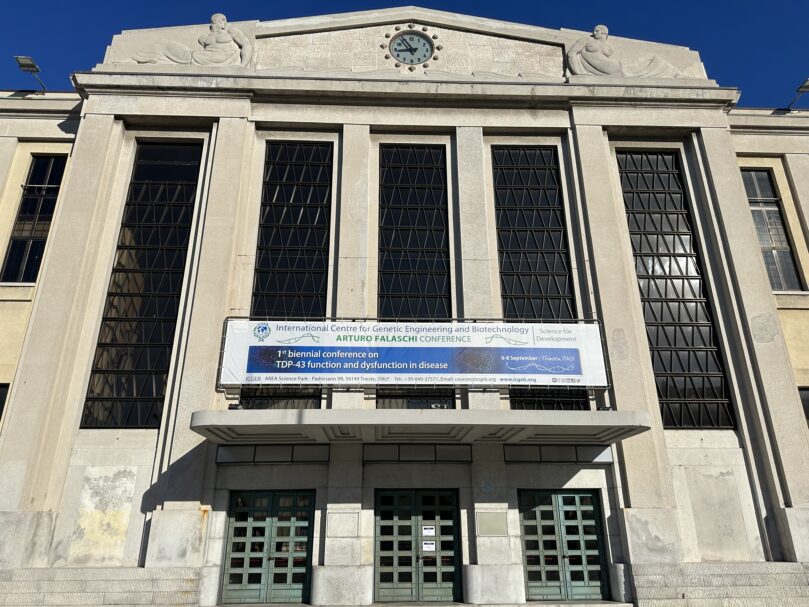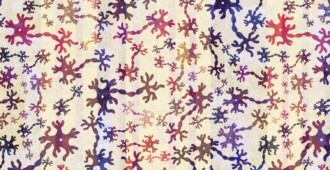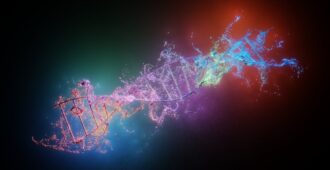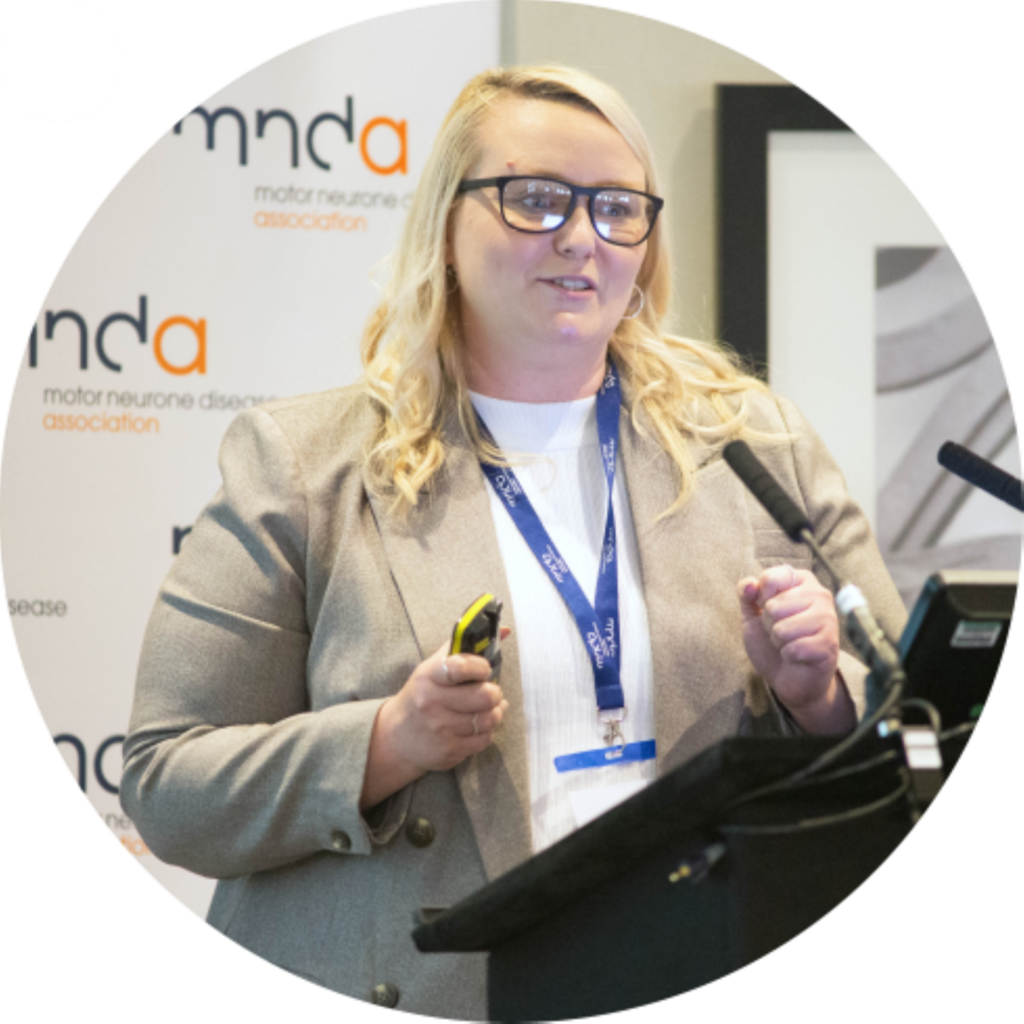
Hi there! I’m Dezerae, and I am currently a Lady Edith Wolfson Junior Non-Clinical Research Fellow at the University of Cambridge. My work, supported by the MND Association, seeks to develop new tools that enable us to evaluate models of MND we use in the laboratory for research and therapeutic testing.
Recently, I have been focused on a protein, one of the fundamental building blocks of every cell in our body, which goes rogue in up to 97% of people living with MND. This protein is called TDP-43. It forms clumps (”aggregates”) in specialised brain cells called motor neurons, and is thought to be intimately linked to the death of these cells which underlies all forms of MND.
Recently, I had the privilege of attending the 1st biennial conference on TDP-43 function and dysfunction in disease held at the beautiful Stazione Marittima in Trieste, Italy. As the name implies, this meeting was the first of its kind specifically seeking to bring together people from all around the world whose work is focused on TDP-43; from how it is encoded in our DNA, to how the protein is produced, regulated and functions in healthy cells, to how failures of its function can lead to disease. In contrast to traditional meetings focused on a specific disease or cellular phenomenon, there was a uniquely singular focus on TDP-43 and all aspects of its biology.
The meeting was opened by local host Emanuele Buratti. Dr Buratti treated the audience, spanning students to established giants of the field, to a trip down memory lane. Sharing photos of original results and hand-drawn annotations from his lab books from the late 1990’s, Buratti gave early context to a field that has gone on to span more than two decades. It set the scene for a fantastic program featuring presenters from around globe who would go on to describe novel experimental approaches, advances in our understanding of how TDP-43 relates to MND, and new therapeutic strategies that are gaining traction toward clinical trials. Recounting it all would take longer than the meeting itself (unfortunately a case of ‘you had to be there’!) but I am delighted to have the opportunity to share a snapshot of some of the outstanding science with you.
An early highlight came in the form of a potential new therapeutic strategy, described by James Shorter in his presentation “(Dis)solving the problem of aberrant protein states“. Recent work from Shorter’s team has focused on the normal function of TDP-43 in cells which involves the separation into a distinct phase, similar to how oil comes together to form droplets in water. If TDP-43 stays in this separated state for too long then it can turn into elongated aggregates similar to those associated with MND. Shorter’s team have leveraged the ability of RNA, another fundamental cellular building block, to manipulate the phase formed by TDP-43 and reverse the abnormal phases. In theory, this could prevent or even reverse the characteristic clumps formed by TDP-43 in those living with MND – an exciting proof of principle that offers a promising potential new strategy toward viable therapeutics.
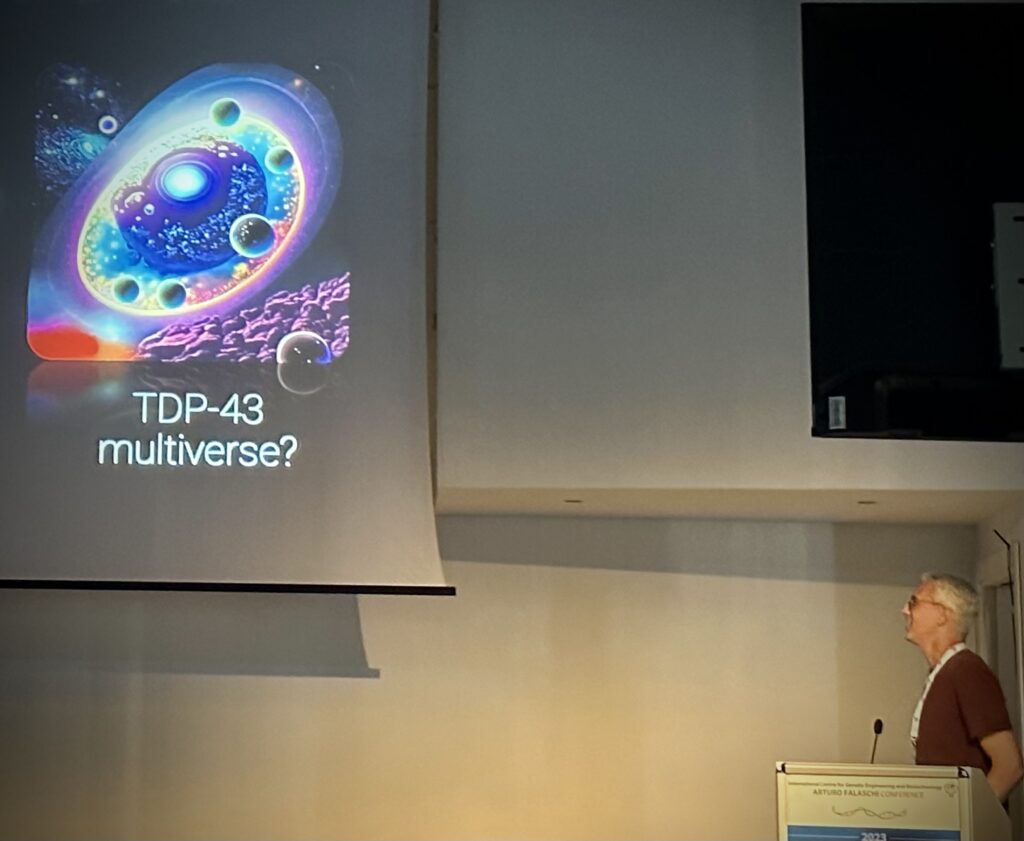
Competing for best pop-culture reference, Michael Ward introduced us to the TDP-43 Multiverse during his talk titled “Functional genomic strategies to identify regulators of neuronal TDP-43 biology”. Just as big data has taken the world by storm, biology is now generating and exploiting bigger datasets than ever before. Ward’s research encourages us to ‘think bigger’ when it comes to TDP-43. Using computational tools, his team combines datasets from a variety of sources including different cell types and a range of biological molecules such as DNA, RNA and proteins, in an attempt to unravel the chaos that erupts in neurons when TDP-43 function is lost. The resulting data may let us pinpoint the effects of losing TDP-43 function that are specific to motor neurons, a key mechanism of MND that remains unknown.
Late on the second day Alyssa Coyne presented “Large scale analysis of sALS and C9orf72 ALS/FTD iPSNs reveals defects in TDP-43 function repaired by genetic therapies”. In essence, a tour de force analysis of the ANSWER ALS collection of cell models created from people living with MND, which are an invaluable experimental tool. Alyssa asked a simple question, which is similarly at the heart of my research: How good are these models at capturing what we see in real people? One of the principal functions of TDP-43 is in processing RNA. RNA plays a vital role in our cells by converting the instructions from DNA to make proteins. TDP-43 processes a collection of different RNAs, which form a characteristic signature. Looking at the signature in cell models and comparing them to those of the corresponding donor allowed Coyne’s team to establish that signatures are variable between patients, just like fingerprints, but that cells can faithfully recreate the signature of their matched donor. These signatures together pointed toward defects in how molecules move within cells in MND. When TDP-43 is dysfunctional, it is found to move from the DNA storehouse – the nucleus – into the larger cell body, where it forms clumps. Correcting these defects has been shown to enable TDP-43 to process RNA properly, again offering hope of a new potential target for therapeutic intervention.
Last but not least, the poster session — where many early career researchers showcase their work — is always a firm favourite, and this one did not disappoint. With the backdrop of a stunning sunset, attendees were treated to some stellar discussions from the future of the field. Carlo Scialò shared his progress towards the ultrasensitive detection of TDP-43 in nasal swabs; Oscar Wilkins described a new computational tool, SpliceNouveau, to help design next-generation therapies; and Diana Arseni described her groundbreaking work delivering an atomic-scale picture of the shape TDP-43 adopts when it forms the toxic aggregates found in MND. Such sessions are an invaluable opportunity to make connections, discover new technologies and see ‘fresh-from-the-bench’ science.
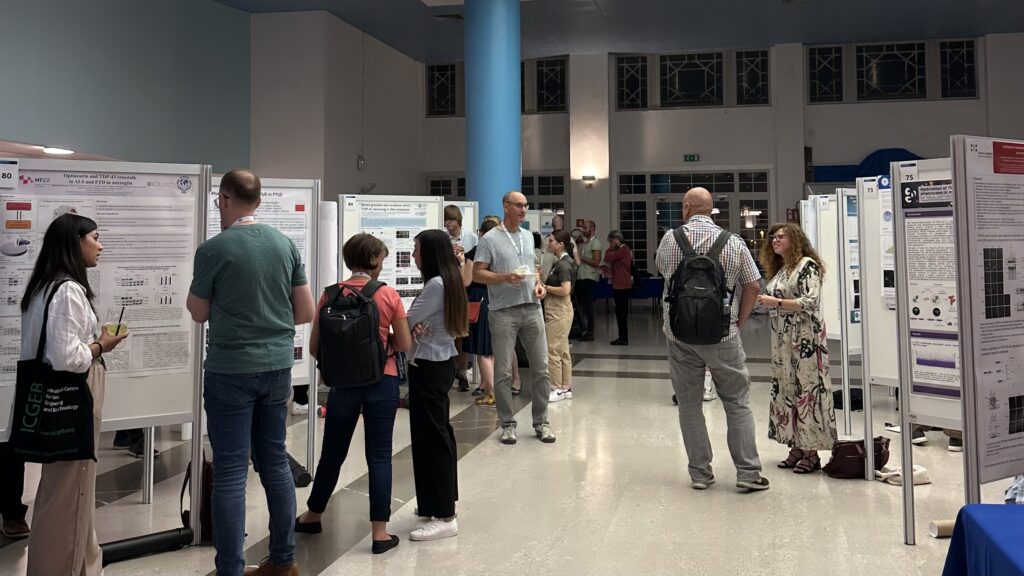
In all, this really was a fantastic event spanning all manner of biochemical, biophysical and clinical approaches to understanding TDP-43, a molecule at the heart of MND. I learnt more than I thought possible and am so grateful for the opportunity to immerse myself in this welcoming and exciting research community. I have no doubt that the collaborations forged throughout the meeting will drive TDP-43 research forward, and I can’t wait for the 2nd conference on TDP-43 function and dysfunction in disease in a few years’ time!
Can’t get enough TDP-43? Find out more about my research here, or check out the complete conference program here. For anyone interested in the next iteration of the meeting, stay tuned – I look forward to seeing you there!
We would like to thank Dezerae for taking the time to write this blog. Dezerae’s Lady Edith Wolfson Junior Non-Clinical Fellowship is funded by the MND Association. Thank you to the Cambridge Branch of the MND Association who have helped to support her work.

